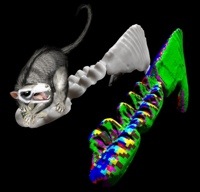Paleontology
We analyze patterns of diversity in the fossil record, with special focus on ecological factors in explaining evolution of certain phenotypes. Tooth shapes are invariably complex and difficult to fully characterize, and we are developing approaches to allow ‘fast-throughput’ analysis of three-dimensional shapes. We have identified dental complexity as an ‘ecometric’ measure that links overall dental form to diet, irrespective of the phylogenetic affinities of individual species. To study natural and mutant phenotypes, we have developed a computerized MorphoBrowser database for three-dimensional phenotypes . Other tools have been implemented in the ToothKit program.

Above: Dental complexity in mammals is more closely related to the diet than to phylogeny, with high complexity in herbivores and low complexity in carnivores. We have measured dental complexity using GIS procedures for separating the tooth surface into functional components.
Evans et al. (2007) Nature


